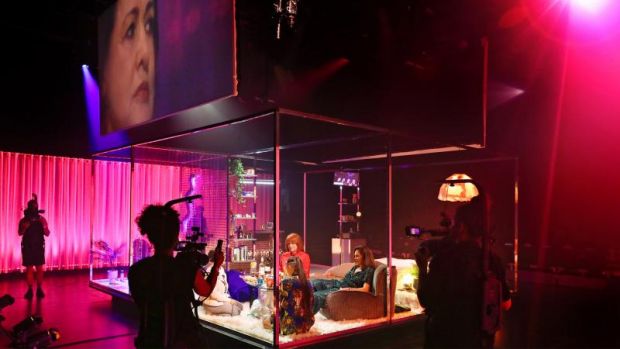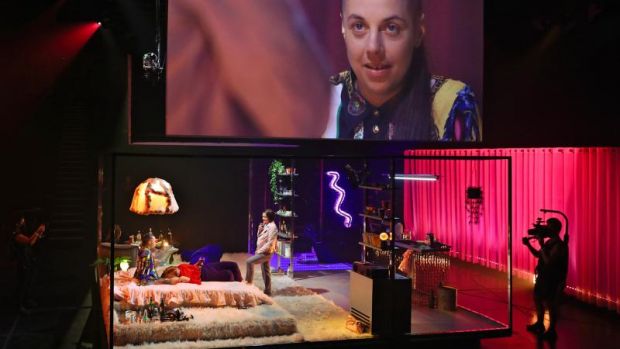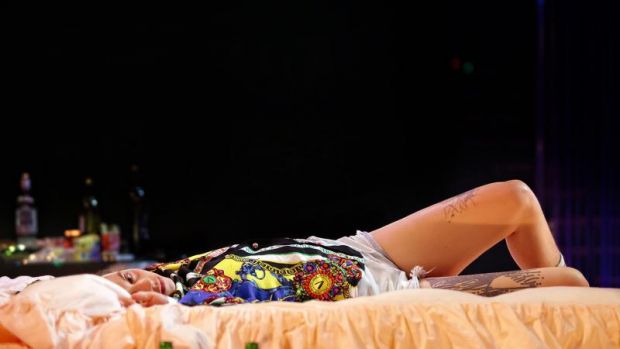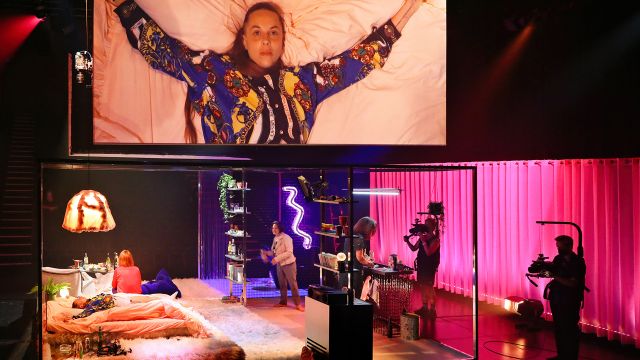Set Piece
Set Piece is a curious experiment. It attempts to overturn certain theatrical conventions and to construct alternatives. The show’s creators, Anna Breckon and Nat Randall, place a statement in the foyer, stating their objective and intentions and clearly preparing the audience for what they are about to see. We should leave aside why they felt it was necessary to do this – but it its, as intended, illuminating.
The assertions made in this foyer statement – and the program notes - are bold, even extravagant. They began thinking about the play, they say, ‘with a desire to capture the quality of being in a relationship without the conditions of plot, objectives, and dramatic stakes.’ (Is this possible?) They sought ‘alternative temporal structures… connected to the erotic – compulsion, repetition, fumbling, hovering, edging.’
But what happens on stage? The audience is on either side of a detailed, semi-naturalistic set: an apartment with a kitchenette, a bedroom, a living room, and a loo (design by Genevieve Murray), owned by two of the characters (Maude Davey and Dina Panozzo) who are in a long-term lesbian relationship – meaning they don’t take much notice of each other. They are hosts to another lesbian couple (Nat Randall and Carly Shepherd), also in a long -term relationship – although we can infer that this second relationship is perhaps not as secure at the first.

Four cameras cover the action and what they see, controlled by a backstage vision switcher, is projected on huge screens suspended above the set. That foyer statement refers to how the ‘technologies of magnification [i.e., the cameras] can make room for alternative performance styles.’ Think Ivo von Hove, or the STCs Kip Williams. In practice, what we get here are – mostly – extreme close-ups which reveal more emotion than is visible from the actors on stage.
The women’s dialogue, which we are told ‘draws on real-life dinner party conversation, improvisation and 50s pulp fiction’, is mostly flat, banal, and desultory. Cliches are uneasy and don’t connect. One woman (Davey), elegant in a spangled jump suit, is cold, distant, bored and patronising as if she could easily do without their guests. Perhaps her partner, who is relatively lively but patronising in her own way, has invited them. Indeed, there seems to be no warmth, no connection, no relationship between the couples. The younger woman of the second couple seems naïve but manipulative. For some time, we wonder why the second couple is there. While what we are seeing conforms to the foyer statement, and there is some forced-sounding, I-get-it laughter from the audience, this first section is, really, pretty dull – but we are expecting more and it comes...

It’s a splendid trick – almost a coup de theatre - played on the audience. Suddenly there is a lighting change, the women stop in mid-sentence or mid-move, and a PA announcement tells cast and camera operators to clear the stage. We are told that there is a technical hitch, it will be rectified, and then the play will resume. Of course, we believe this. We can see that complex technology is involved here, even if we do think, ‘Haven’t they worked out all the tech problems by now?’ After five or so minutes, we are thanked for our patience, and the play will now resume. Cast back on stage, camera operators – two one side, two the other – back in place.
But the play does not ‘resume’ – that is, ‘resume’ as in ‘pick up where we left off’. No, we ‘resume’ in a different place and we realise that we are hearing dialogue and seeing moves that we have seen before but not in the same order – before the ‘technical hitch’. It’s an ‘alienation technique’ – not especially necessary in this case, but suddenly, Set Piece is funnier, more pointed. We get it. It’s also sadder. Text and performance circle and repeat. The banality, the subterfuge in the subtext is revealed. Characters go to the loo, pull down their pants or jump suit, and sit there – several times. Why? (No one washes their hands.) There is some minimal ‘development’: two characters dance together and kiss. There is some sexual play – rather tepid. There is some uncertainty met by nastiness – thus pathos. More repeated dialogue… Until the next ‘technical hitch’ – and the next - after which we ‘resume’ and the dialogue and the moves circle and repeat.

The program notes say that ‘Randall and Breckon upend the tropes of relationship drama to mine the rich depths of queer relationships and the emotional dynamics contained within.’ Up to a point, yes. But what occurred to me, what I inferred from what I was seeing – and I’m guessing Breckon and Randall would not at all agree with the word – was satire. But satire in the name of what? Rather than exploring the ‘rich depths of queer relationships’, what I was seeing suggested that here there are no ‘rich depths’. These four queer characters are, like most human beings, caught in spirals of self-consciousness, status anxiety, fear, clumsy desire, and cliché.
Randall and Breckon are serious. They have thought about how theatre works, and they do want, through their ‘alternative temporal structures’ and the cameras, to reveal the dynamics of queer relationships. Have they? They say they want to show ‘how sexuality registers as a set of moves, a spatial orientation, a rhythm’. But I would question just how much the audience is aware of sexuality at all – except perhaps for some flirting and brief fumbling. By denying themselves ‘plot, objectives, and dramatic stakes’, the writers deny their characters any chance of engagement with the audience. That is, of course, intentional. But it’s why I’ve called Set Piece an experiment. For me. not a very successful one, and at the end we might ask, ‘And the point is…?’
Michael Brindley
Photographer: Prudence Upton.
Subscribe to our E-Newsletter, buy our latest print edition or find a Performing Arts book at Book Nook.

